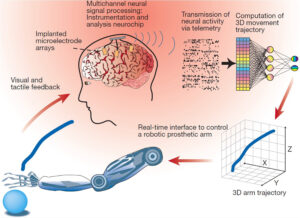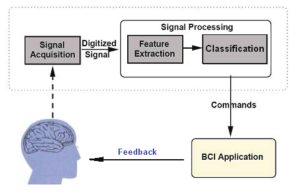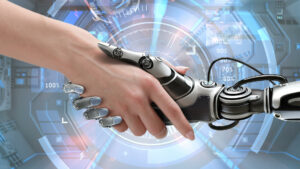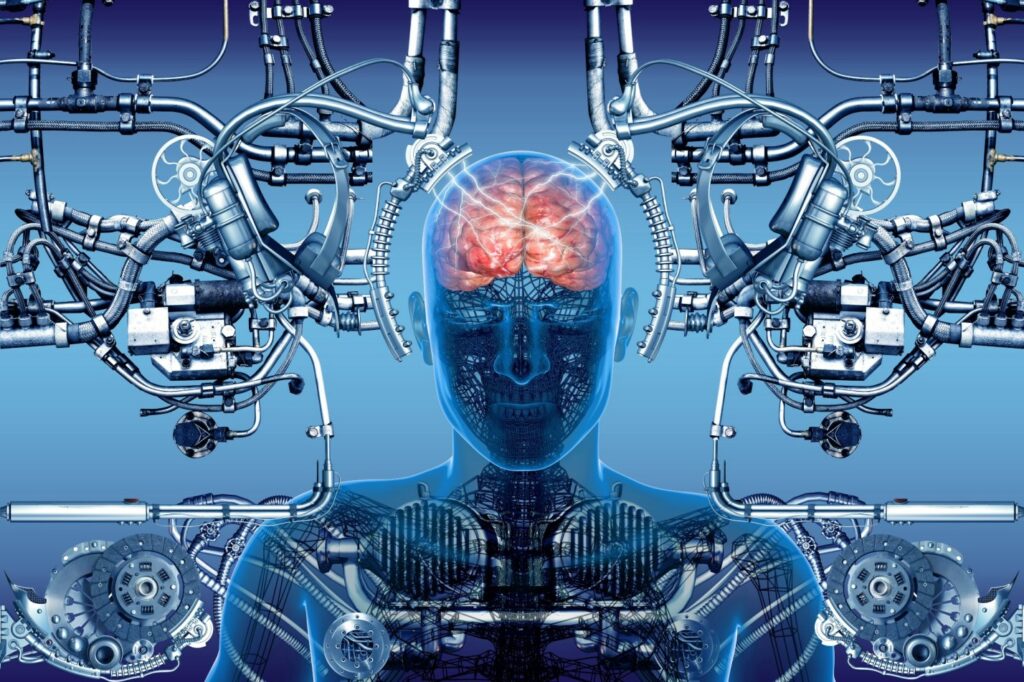
Introduction and Basic General Information to Describe Neuroprosthetics and Their Significance
Neuroprosthetics are essentially devices that connect with the nervous system to help improve the function of damaged body parts. Although the mechanisms of these devices can be fairly complicated, most all tend to function through a series of receiving and interpreting electrical signals from the nervous system.1 Though the first of these devices would seem primitive from a modern day technological point of view, the concept of neuroprosthetics has become increasingly important in society. Diving deeper into the discussion referencing neuroprosthesis, the aim of these products is to replace or reconstruct different parts of the nervous system that have been obstructed by neurological disease and/or injuries.2 As one might imagine, the complexity of the nervous system and all the moving components within is extremely intricate. Because of this convoluted network, it makes not only the invention but the application of these products highly challenging to produce. With that in mind some might question if it is even worth going through what can be a long and grueling process to develop neuroprosthetics. However, the potential upside of neuroprosthesis as a whole is incredibly vast with the ability to shock the medical world, especially with further development.3 Some of the beneficial utilities associated with these products include improved mobility, increased sensory feedback, and enhanced communication. Overall, many of these devices allow for an improved quality of life by contributing to the betterment of the associated patients.4 Furthermore, the efficiency of neuroprosthetics relies on the development of researchers in fields like neuroscience, engineering, and computer science.5 Regarding the research areas of neuroprosthesis, brain-computer interface is among the key the most promising. It allows for individuals to control the devices with their thoughts through a series of signal processing. Additionally, this type of technology has the potential power to not only change lives, but also alter the way in which many medical conditions are approached as a whole.6 It is without doubt that neuroprosthetics will play a major role in the future of medicine and neuroscience. However, where there is progress there is bound to be regulations and concerns regarding it. With that being said an issue regarding the development of neuroprosthesis is their ethical usage. When new ideas come into play there can be unforeseen consequences. Neuroprosthetics face many ethical concerns that must be addressed before their integration into the population.
History and Evolution
The history of neuroprosthetics can be traced all the way back to the idea of using electrical stimulation to restore neurological dysfunction. The first neuroprosthetic was invented in 1957 when a physician in Paris operated on a deaf man to improve his hearing. From this point on the concept and integration of neuroprosthetics has steadily evolved. The next breakthrough came in the early 1960s by a man named Blair Simmons. As a professor in the otolaryngology department he installed a cochlear implant which is a device that stimulates the auditory nerve through electrodes placed in the inner ear that allows for deaf patients to perceive sounds.7 Continuing the progression of neuroprosthetic development, another milestone worth mentioning would be that of Tactile Television. Also referred to as haptic television, it is a way for individuals possessing some form of visual impairment to experience tv through touch. It works by implementing a series of individually controlled pins on a grid that allow the user to detect vibrational patterns.8 By doing so, patterns create an image that can be quote on quote read. In a sense one could think of this neuroprosthetic almost as an advanced form of interpreting braille.

Jumping drastically forward in both time and technology comes the introduction of BrainGate. Developed by Dr. John Donoghue and his research team at Brown University in the early 2000s, it is a brain-computer interface that allows for people with neurological dysfunction, primarily paralysis, to control neuroprosthetic devices using their thoughts.9 This invention best describes the relationship between what the initial neuroprosthetics were striving to be and the base for which they have the unlimited potential to grow. BrainGate is a very complex device that must work at a highly efficient level to function properly. First the BrainGate sensor, which is around the size of a small pill, is implanted into the brain through a noninvasive surgery. Once implemented the sensor receives and transmits signals from neurons in the motor cortex. Using a highly sophisticated algorithmic system, it is able to interpret these signals into commands that can control external devices like prosthetic limbs, communication devices, and other neurologically based apparatus.10 However, it is worth mentioning that BrainGate is still in the experimental phases of its development and not widely available to the public at the moment. With that being said, BrainGate could easily serve as the basis for which further neuroprosthetic information is developed. As further research is refined it could prove to be a major influence on brain-computer applications in the healthcare field as well as other technological based areas.
Moving on to probably the most known up and coming form of neuroprosthesis, Elon Musk’s Neuralink. Similar to that of BrainGate, Neuralink functions through a brain-computer interface. However there are differences that set the two apart. For one, the implantation of the Neuralink chip is much more broad when compared to that of Braingate. While Braingate focuses specifically on the motor cortex, Neuralink covers a more extensive area. The second area where the two devices differ comes in reference to their purpose/goal. Braingate is primarily focused on restoring the functionality of people with paralysis or other disabilities using their thoughts.11 On the other hand, Neuralink’s goal is to develop a range of applications for their technology. Instead of just focusing on neurological conditions, Neuralink also wants to enhance the cognitive abilities of the patients using artificial intelligence (Fiani, and Reardon, 2021). Lastly, the two companies are in different stages of development. Since BrainGate has been around longer than Neuralink, it has conducted more clinical trials in humans. While Neuralink has had successful implantations with rats and monkeys, they have only just begun conducting clinical trials with humans.12
As one can see the future of neuroprosthesis is likely to have a big impact in the years to come. Along with a heavily increased understanding of the brain and its functions, the opportunity to improve millions of lives is of great potential.13 While it is difficult to predict exactly what the future of these devices looks like, in this rapidly evolving field there are bound to be numerous possibilities. Only new innovations and developments will tell for sure. However, there are certain areas where speculation could prove to be pretty accurate. For example, these new devices will likely be more advanced with an increased compatibility and possibly even non-invasive. Overall as long as the improvement in quality of life is the focus, it can be said with confidence that there are big things coming.
Technical and Ethical Issues Regarding Neuroprosthetics
With regards to neuroprosthetics there are still many technological issues being faced within the industry. One concern associated with the use of neural prosthesis is the biocompatibility factor. While it is probably the first thing that comes to mind when the idea of neuroprosthetics comes up, it can also be the most challenging. These devices must be durable enough to withstand the harsh environments of the body while also making sure not to cause any unwanted reactions. This brings up concerns with things like tissue reaction, biodegradation, and stimulation. Essentially, developers are going to have to engineer these devices to be almost perfectly compatible and lasting to ensure their longevity. Another problem retaining to this topic is the sheer magnitude of how technologically advanced some of these devices have to be. While the instruments must have a power supply to ensure longevity, the devices must also be miniaturized enough to fit inside patients.14 Along with this comes all of the processing that is required for the devices to be useful. Because they generate so much data from sources, it must be processed to be efficient. This then leads into the signal processing phase of the neuroprosthetics and their ability to process electrical signals from the nervous system. Encompassing all of these already highly complex issues, the issue of the accuracy and precision of these devices comes into question. Any errors in the signal processing system could lead to major side effects or reduced efficiency in the devices.

While the thought of neural prosthesis may be found very appealing in theory, it is worth mentioning that just like almost any other revolutionary idea there are many ethical concerns associated with them. An example of this would be the issue of morality. There is little to no information known about the long term effects that some of these devices could have. So, while patient consent may not be a problem it comes into play that they might not even know what they are consenting to. In many cases a simple malfunction could result in serious damage which raises concerns about patient safety.15 Another factor leading into the ethical discussion regarding this subject is privacy. Because the implantation of some of these devices often requires information about the mental and/or physical state of a patient, it raises the question of who has ownership over this data. Not only could this information be used in unethical ways, but it could result in countless lawsuits.
Conclusion
In conclusion, neuroprosthetics are a rapidly developing topic that contain the potential to not only change millions of lives, but alter modern life as we know it today. While these devices are an extremely advanced form of technology in many cases, their ability to improve loss of function due to impaired neural purpose or other disabilities is an exciting path worth exploring. Despite the many obstacles standing in the way of development over the years, scientists have been able to make outstanding progress. Additionally, the progress and evolution of these products has been very significant, especially when referring to the recent years. There have been several demonstrations of neuroprosthesis ability to restore both motor and cognitive function in patients.
However, even with these types of strides being made in the industry, there are still several factors that need to be taken care of to ensure optimal functionality. Biocompatibility serves as one of the main concerns regarding these devices development. The safety and longevity of neuroprosthetics must allow for an efficient product while taking into consideration every possible issue that could arise from these products. Furthermore, another matter that must be taken into consideration is the ethical manner of said devices. Safety, privacy, and consent must be prioritized above all when stepping into new waters regarding human life. Notwithstanding these challenges, the benefits that could occur from neuroprosthesis are ongoing. Along with fixing neurological disorders and/or injuries, neuroprosthetics could prove to have significant effects for neuroscience as a whole. By studying these devices, researchers can explore and better understand the inner workings of the brain. With this in mind it could lead to the curing and development of new treatments for a range of conditions.
It is likely that these products will continue to evolve due to the advancement in technology and resources. As these assets begin to open new doors of possibility, the integration of neuroprosthetics will allow for new pathways of life. Most likely the main contributions to the devices will come from a collaboration of researchers in many different types of fields. Lastly, as neuroprosthesis continue to develop, their incorporation into human life will likely revolutionize the way people live.
- Rothschild, R. M. (2010). Neuroengineering tools/applications for bidirectional interfaces, brain–computer interfaces, and neuroprosthetic implants – a review of recent progress. Frontiers in Neuroengineering, 3. https://doi.org/10.3389/fneng.2010.00112 ↵
- Gupta, A., Vardalakis, N., & Wagner, F. (2023). Neuroprosthetics: from sensorimotor to cognitive disorders. Communications Biology, 6(1). https://doi.org/10.1038/s42003-022-04390-w ↵
- Rothschild, R. M. (2010). Neuroengineering tools/applications for bidirectional interfaces, brain–computer interfaces, and neuroprosthetic implants – a review of recent progress. Frontiers in Neuroengineering, 3. https://doi.org/10.3389/fneng.2010.00112 ↵
- Gupta, A., Vardalakis, N., & Wagner, F. (2023). Neuroprosthetics: from sensorimotor to cognitive disorders. Communications Biology, 6(1). https://doi.org/10.1038/s42003-022-04390-w ↵
- Warwick, K. (2018). Neuroengineering and neuroprosthetics. Brain and Neuroscience Advances, 2, 239821281881749. https://doi.org/10.1177/2398212818817499 ↵
- Fiani, B., Reardon, T., Ayres, B., Cline, D., & Sitto, S. R. (2021). An Examination of Prospective Uses and Future Directions of Neuralink: The Brain-Machine Interface. Cureus. https://doi.org/10.7759/cureus.14192 ↵
- An, C. (2020, September 27). Neuroprosthetics — A Simple Guide from a Neuroscience Student. Medium. https://medium.com/neurotechx/neuroprosthetics-a-simple-guide-from-a-neuroscience-student-7264740c10d3 ↵
- An, C. (2020, September 27). Neuroprosthetics — A Simple Guide from a Neuroscience Student. Medium. https://medium.com/neurotechx/neuroprosthetics-a-simple-guide-from-a-neuroscience-student-7264740c10d3 ↵
- Warwick, K. (2018). Neuroengineering and neuroprosthetics. Brain and Neuroscience Advances, 2, 239821281881749. https://doi.org/10.1177/2398212818817499 ↵
- BrainGate. (2022, February 9). BrainGate – Turning Thought Into Action. https://www.braingate.org/ ↵
- Fiani, B., Reardon, T., Ayres, B., Cline, D., & Sitto, S. R. (2021). An Examination of Prospective Uses and Future Directions of Neuralink: The Brain-Machine Interface. Cureus. https://doi.org/10.7759/cureus.14192 ↵
- Fiani, B., Reardon, T., Ayres, B., Cline, D., & Sitto, S. R. (2021). An Examination of Prospective Uses and Future Directions of Neuralink: The Brain-Machine Interface. Cureus. https://doi.org/10.7759/cureus.14192 ↵
- Rothschild, R. M. (2010). Neuroengineering tools/applications for bidirectional interfaces, brain–computer interfaces, and neuroprosthetic implants – a review of recent progress. Frontiers in Neuroengineering, 3. https://doi.org/10.3389/fneng.2010.00112 ↵
- Jiang, F. (2022, March 30). BCIs: Merging Mind and Machine – The Startup – Medium.Medium. https://medium.com/swlh/bcis-merging-mind-and-machine-cef4e77d4eb0 ↵
- Vallaeys, F. (2021, August 27). PPC agencies will play these 4 roles when automation takes over. Search Engine Land. https://searchengineland.com/ppc-agencies-will-play-4-roles-automation-takes-287059 ↵



4 comments
Jared Sherer
After reading your article I have learned a lot that I didn’t know about before reading your work. I think you did a great job in your explanation and provided well written and informative information. I think it is pretty cool how this technology is being used to actually help people and I hope it goes far in the future. Hopefully this type of technology will be used for a good cause and won’t backfire on us in the long run! Great work on this article.
Jacob Adams
Although I will probably never take part in neuroprostetics unless a video game is involved somehow. However I’m interested to see how far this tech goes, but I hope it does not take a turn for the worst you mention the long term affects. But, the short term affects will be that this gives the rich elite yet another advantage over low income communities. How can we make this available for everyone?
Bianca Ramos
This was such an interesting read! I’d only learned about technology like neuroprosthetics from sci-fi movies and shows, and that’s not exactly the most informed source of information. So it was surprising to learn how this technology is actually being created to help people. I can completely understand the ethical issues that might arise though. Congratulations on the nomination, and thank you for explaining this topic so well!
Matthew Holland
It is one of the best of its kind in it the respective section hands down. I look forward to reading more from them in the future and hope they can write about different topics that would be equally interesting. It is seriously incredible how much technology is advancing and at such a rate that we may at one point in the future be able to solve any problem a person with a disability might have.